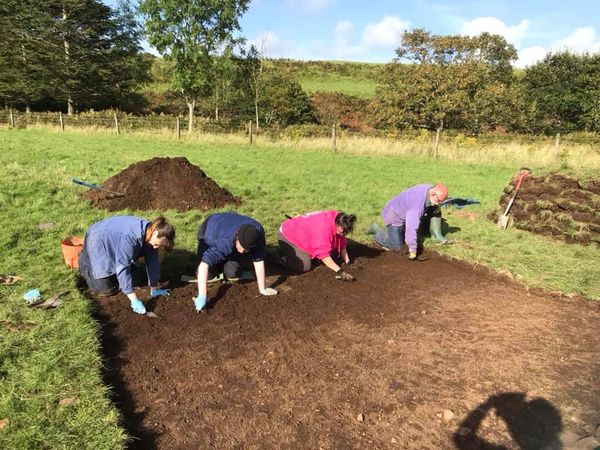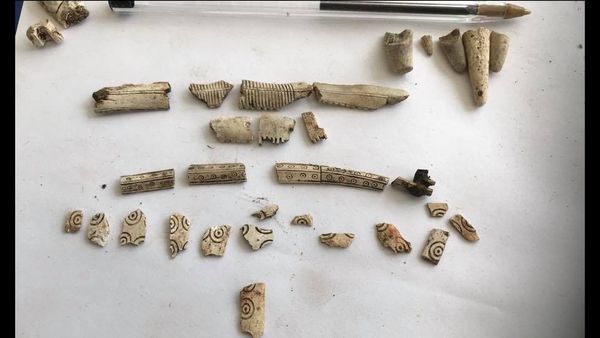Story
Mull Museum are looking for help raising funds for a further archaeological dig and post excavation costs at Lephin, Glengorm on the Isle of Mull after the exciting results of the September 2018 and 2019 excavation with the discovery of a Norse settlement. We will also be looking for volunteers to join in and help with the digging, so if you are interested in archaeology and getting down and dirty, no experience necessary, then read on ........

WHAT WE WOULD LIKE TO DO IN 2022
Further research .............. We would love to be able to confirm whether there was more than one Norse period building at Lephin and what these may have looked like and what happen in and about them. Also we want to confirm whether the Norse farmstead was indeed enclosed within a wooden fence/palisade and what this may have looked like. Although the same community team partially excavated a Norse period building at Baliscate, also on the Isle of Mull, no other Norse settlement has been excavated in Argyll and Lephin provides an exciting opportunity to understand how these farm settlements may have been laid out and how they worked. This site starts to add flesh to the bones of our understanding of Viking/Norse settlement in Argyll which until now has only been presumed to have existed due to the high number of Scandinavia derived place names.
Also near to Lephin a couple of long mounds have been identified as potential boat burials and it would be our intention to evaluate these to determine whether that’s what they are or something else.
This project will involve the community, schools, etc in exciting and very meaningful archaeological research. All primary and some high schools classes will be invited to come along and be involved in the excavation, in 2019 the pupils actually came in wellies and waterproofs and got down into the trenches and helped with the trowelling.

Summary of previous work in 2018 and 2019
Previous community led research excavation at Lephin, which is located on the Glengorm Estate on the Isle of Mull has resulted in the discovery of Norse period (probably 11 th century AD) settlement. This is a very rare discovery with only one other similar period building having been discovered on Mull and only a handful excavated on the outer Hebrides. We have evidence that there were probably a number of buildings perhaps enclosed with a large wooden enclosure/fence. The buildings would have probably been mostly built out of turf, with minimal use of timber. We have discovered a large hearth which would have been located within the centre of a turf longhouse and about which daily life would have been played out. Someone living here was a skilled crafts person, making fine decorated antler objects and which may have included a decorated antler comb and case; we even have a specialised craft knife which may have been used to make these objects. The occupants of the house also worked metal and sharpened their metal tools using a whetstone. These people also made their own pottery and they were proficient farmers, growing a variety of crops as well as collecting wild foods such as hazelnuts. The type of tools used in this house and the nature of the decoration of the antler comb and case strongly indicates that the people living at Lephin were of Scandinavia origin and probably represent settled Viking immigrants/colonists.
The Norse settlement was replaced by a stone and turf rectangular structure in the late 12 th or early 13 th century. The subtle change in construction technique may indicate that the people occupying the new farm were related to those of the earlier Norse settlement. A series of earthfast posts set around the interior walls would have supported a timber roof. The interior of the structure comprised a series of midden- like floor deposits within which were carbonised cereal grains, slag and worked metal objects and fragments of pottery. It is clear from the archaeological evidence that the people living at Lephin at this time were competent, largely self-sufficient farmers. The farmhouse was rebuilt in the late 14 th or early 15 th century. Additional postholes and a gully were also recorded below and sealed by the lowermost floor deposits, indicating that there is an earlier structure (possible Norse) underneath the main one, although we have no immediate dating evidence. A burial, dating from the 17 th or 18 th century was also discovered under the rubble of the main structure.

UPDATE 1/10/19
Here is a summary of the exciting results from the excavation at Lephin in September this year -
WE FOUND
10th century pits with domestic rubbish in them including the remains of a decorated comb and lots of early pottery some with patterns.
Possible evidence of bone working (antler tips etc)
Sunken feature with hearth, resembles Norse structures
Probable later metal working location
Rune stone – possibly not runes but NMS will confirm one way or other
Norse period settlement
Possible chapel (as long as burial is contemporary) but which was also used at some point as a farmhouse – hopefully the post-excavation will help us decide whether the chapel was multifunctional or its use as a farmhouse was later
No burials in the enclosure along with scarcity of burials within the interior of the chapel may indicate that it was a private chapel for wealthy landowner
Adult burial
Stone setting – unknown function (corn stook?)
Gully in enclosure and in the chapel, along with earlier postholes indicate and earlier settlement, possibly part of the Norse settlement already identified
THE STORY ABOUT LEPHIN
It is very early days but we are really excited about our community excavation at Lephin, on the Glengorm Estate, on the beautiful Isle of Mull. A week of extremely hard and industrious work by all has demonstrated the presence of a probable 13th century massive walled stone structure enclosed by an equally massive stone enclosure under which might be a Norse period structure.
We originally mapped the site as part of the Baliscate project http://archaeologydataservice.ac.uk/library/browse/issue.xhtml?recordId=1146553&recordType=MonographSeries as it was recorded as a burial ground on the 1st Edition Ordnance Survey Map and in plan was very similar in size and form as the enclosed structure at Baliscate. Despite 28 solid days of community excavation at Baliscate we failed to definitively prove that the enclosed structure (actually there were at least two structures the first having burnt down) was a chapel. Frustratingly the underlying cemetery dated to the 7th/8th century AD while the structures, with no definable contemporary burials, dated to late 13th and 14th centuries.
So the question remains are sites such as Balicate, Lephin, Crackaig, Cillchriosd and Cille Mhuire enclosed chapels or medieval farmsteads. The RCAHMS have argued that Lephin is a farmstead and indeed there is a later winnowing barn built over the ruin enclosure wall but if this is the case then why does the oral history of the site recognise it as a burial ground? We wanted answers…..
After a week of toiling (and lots of delicious homemade cake) we now know that the structure was in use during the late 12th and first half of the 13th century. It was largely constructed from stone, with an internal wooden frame of earthfast posts that would have supported the weight of the roof. We recovered from the filthy floor deposits lots of carbonised cereal grains including oats, barley and some flax), heaps of pottery sherds, loads of charcoal from all sorts of wood and even some yew (typically only found on church sites) as well as evidence of metal working… mostly stuff not what we would typically associated with the interior of a chapel. So confusingly were also found within the stone enclosure a stone lined cut, possible a large grave cut, although no bone survived in the excavated portion.
Finally just outside the enclosure wall we found a massive burnt deposit that appears to represent in situ burning and significantly it went under the enclosure wall, so it is clearly earlier in date. It contained lots of small fragments of burnt bone and masses of charcoal. When the retent from the bulk sample was sorted fragments of a bone comb decorated with circles and parallel lines were recovered and initial searching online indicates that this decoration occurs on other combs and the decoration on one comb which was recovered in Gotland, Sweden and which is dated to the Viking period bears an uncanny resemblance. A radiocarbon date from the charcoal has confirmed that the fire was made in the 11th or 12th century AD.
WHAT WE WOULD LIKE TO DO NEXT
We are currently applying for various grants and funding to return next year. Our aim would be to uncover a good portion of the interior of the structure to determine how the building was used and whether there are burials beneath those floors and if so when do they date to. We also want to explore outside and under the enclosure wall to see if we really do have a Norse period hearth and to see if there is an associated structure..... This could be the first known Viking/Norse building on Mull, how wonderful it would be to excavated it!
The aims of the second season (2 weeks) of excavation in September this year 2019 are to:
1.to reveal the interior of the structure, explore the internal deposits and establish the presence or absence of graves within it
2. to ascertain whether the central structure has earlier phases
3. to determine the nature of the early burnt horizon and establish whether there is an earlier, Norse period settlement
4. ascertain the condition of preservation of the structural remains and if present human remains
5.contribute to our understanding of these potentially important clearly medieval and perhaps ecclesiastical sites
6.enhance the historic environment record
7.ensure the long term preservation of the site through the production of a site management statement
8.involve the local community and in particular local primary school children in the exploration of their historic environment
9.encourage tourists to visit the excavation and thereby generate interest in the historic environment of the Isle of Mull
All money raised will go to the funding of the excavation and help pay the professional archaeologists, the analyses of finds, radiocarbon dating and writing up of the project etc.